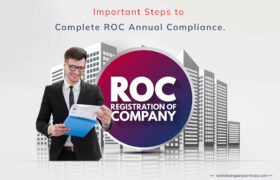What Exactly Is a One Person Company (OPC)?
A One Person corporation, or OPC, is described as a corporation with only one member under Section 2(62) of the Companies Act. This individual must be both a non-minor and an Indian citizen. He is entitled to 100% of the company’s income and shares. Furthermore, in order to lawfully operate a One Person Company in India, it must be registered. Section 3(1)(c) of the Companies Act states that an OPC must be registered as a Private Limited Company, and Section 4(1) states that its name must end with “Private Limited” in its Memorandum. As a result, an OPC inherits all of the characteristics of a Private Limited Company. Take a closer look!
OPC’s Key Characteristics:
- Ownership by a single person
- Limitation of Liability
- Structure of Management Separate
- Legal Individuality
- Existence indefinitely or continuously
Is OPC Registration Required in India?
OPC, like all other companies formed under the Companies Act, is required to be registered with the Registrar of Companies. An application for this can be submitted online through the MCA Portal. The application must include accurate information about the company, its shareholders, directors, and nominee. Furthermore, specific supporting documents must be presented in order for the application to be approved. It should be noted that failure to comply with the OPC registration process and inadequate submission of OPC Registration Documents will result in your firm operating unlawfully in India. This could result in severe legal penalties, including the government forcing the closure of your company.
List of OPC Registration Documents in Extensive Detail
A categorised list of OPC Registration Documents is provided in the table below. The original set of paperwork belonged to the company’s promoters, who were the company’s first stockholders and directors involved in its development. The second set of documentation concerns the Company’s Registered Office. A Registered Office is the address at which the ROC registers the firm. It appears as the company’s official correspondence address in all government records and documents. Finally, the company must draft and submit certain constitutional drafts to the ROC in order to be incorporated.
How to prepare documents for OPC Company Registration?
While submitting OPC Company Registration documents, it must be ensured that they are drafted or prepared in their prescribed formats only. Not submitting the documents in their correct formats may result in the rejection of your application. Moreover, documents like DSC and DIN have to be obtained by filing separate applications. It is necessary to understand the process of such application to ensure completion of documents for OPC registration. Below is a full explanation of how to draft and get these documents, as well as their main purpose in the OPC Registration. Promoters’ KYC Documents: Promoters’ KYC documents are the most fundamental of OPC Company Registration documents. These include a PAN Card for income verification, an Aadhar Card as proof of identity, and a recent utility bill (electricity bill, water bill, or landline bill that is less than two months old) as proof of address. All these documentation must be acquired from each promoter of the OPC. Before they may be submitted with the application, they must be scanned and self-attested. Proof of Registered Office Location: To establish its domicile at the location, the applicant company must show documentation of registered office address. Any recent utility bill (not older than 2 months) in the Company’s name with the registered address on it can be presented for this reason. No Objection Certificate: No Objection Certificate is a declaration issued by the Office Property owner declaring that he does not oppose to the establishment of the company’s registered office at his property. The Certificate must be drafted as per the approved format. You may get the NOC format here. Note that NOC is one of the essential OPC registration documents that must be presented whether the registered office is owned or rented. Memorandum of Association: The Memorandum of Association or MOA is the constitutional document of the OPC. It comprises all the company’s legal details such name, registration address, liability, capital, and commercial activity. The document is drafted on a stamp paper, and signed by the shareholder in the presence of a public notary. The notary then stamps the MOA for which appropriate stamp duty and notary charges are paid. The MOA is written in the prescribed format, with clauses carrying independent information. These clauses are listed in chronological order below:
Clauses of an MOU:
- Name Clause – Mentions the company’s reserved name.
- Address Clause – Specifies the state where the Registered Office Address is located.
- Object Clause – Mentions the OPC’s core business activity / operations.
- Liability Clause – Discusses the type of liability that the OPC provides to its shareholders. This can be liability restricted by shares, liability limited by guarantee, or liability limitless.
- Subscription / Capital Clause – Mentions the OPC’s authorised capital, all shareholders’ names, and their respective shareholdings in the OPC.
- Nominee Clause – Mentions the shareholder’s nominee’s name, address, and other information.
- Because preparing the document needs precise adherence to a set structure, it is recommended that you get legal guidance from our professionals.
- Articles of Incorporation: Another constitutional OPC Company Registration document is the Articles of Association. It contains the internal management norms and regulations. The document must also be written on stamp paper and signed by the shareholder in front of a public notary. After paying stamp duty and notary fees, the notary is needed to stamp the document. However, no specific format is required for its creation. Because each organisation has its own set of internal rules and regulations, the AOA is tailored to the firm’s needs and suitability. It is recommended that you seek legal guidance from our professionals for accuracy in drafting.
- DSC (Digital Signature Certificate): One of the most crucial OPC registration documents is the Digital Signature Certificate (DSC), which is necessary to authenticate the application and material to be submitted. Before the registration procedure can begin, all OPC promoters must have their Class 3 DSCs. To obtain it, an application must be submitted to the Registrar of Companies. The following is a full procedure for filing such an application:
Stepwise DSC Application Procedure:
Select Certifying Agency: DSC is issued by MCA-licensed Certified Agencies. So the first step is to determine which Certified Agency you will submit your application to. For better outcomes, consider elements such as convenience of filing, price, and time required to issue DSC. If you require support, please contact us. Determine the Type of Application and Applicant: After deciding the Agency to file your application with, the following step is to select the type of application and applicant. There are two alternatives for this – PAN-based and Adahar-based. If your cell number is linked to Adhar, you can use an Adhar-based application; otherwise, a PAN-based application is the obvious alternative. Because the promoters are submitting an application for their DSC, the applicant type will be Individual alone. Fill in the blanks: Finally, complete the application form with the necessary information. Adhar-based applications require only the Aadhar Number and the PAN Number. PAN-based applications, on the other hand, require a plethora of details such as the applicant’s name, gender, age, social category, and other personal information. Upload papers: Once the details have been entered, necessary supporting papers must be provided. If the application is Adhar-based, the e-Aadhar must be uploaded in XML format. However, if the application is PAN-based, the applicant’s PAN, photograph, and address proof must be given as supporting papers. Application Submittal & Video Verification: Finally, after paying the DSC cost, the application can be filed. When the submission is successful, a video link will be emailed to the applicant’s registered email address. The applicant must use the link to capture a video of himself reading the script provided by the issuing authority. If supporting documents have been submitted, these must also be shown in the video. DSC Problem: Your DSC application will be completed after the video is submitted. A DSC will be assigned to you and emailed to your registered email address within a few days. Director Identification Number (DIN): Although the DIN is not one of the OPC company registration documents, it is as vital in the registration procedure. Before commencing the registration process, all current directors of an OPC must obtain their DIN. The Ministry of Corporate Affairs, or MCA, assigns DINs once an application is submitted online with supporting documentation. The following is a step-by-step guide to obtaining a director’s DIN:
DIN Support in DIR-3 and SPICE Plus
Select the DIN Application: DIN applications are submitted online using form DIR-3 or Part B of the SPICE Plus application. Both of these forms are available on the MCA’s official website. Fill out the Form: After accessing the application, enter the applicant director’s information and upload the required documents to complete the form. The documents required for the DIR-3 form include the applicant’s PAN, portrait, and address proof, as well as a scanned copy of his signature. However, no further documents are required for DIN application in SPICE Plus. Pay the application fee and submit your application: Finally, submit the form by paying the application fees. The charge for the DIR-3 form is Rs.500, but the fee for the DIN application in SPICE Plus is determined by the allowed capital. DIN allocation: It will take nearly a week to process the application. DIN will be assigned to the appropriate director once the process is completed. Please keep in mind that all current OPC directors must have their DIN before the OPC registration application may be submitted. The SPICE Plus Form can only be used to apply for a DIN of three directors. Declarations and Forms: Certain forms and declarations are among the documentation required for OPC Registration. Their formats and purposes are as follows: DIR-2: The director’s approval is required for their nomination to the OPC. During the OPC Registration procedure, this consent is communicated to the ROC using Form DIR-2. INC-3: During registration, INC-3 must get the nominee’s consent and notify the ROC of the same. INC-9: The declaration of directors is required for OPC registration. According to the declaration, the directors are not guilty of any legal offences or breaches of duty. All of the directors must sign it. INC-14: An INC-14 is a declaration provided by a practicing professional such as a CA, CS, or Advocate that the registration application contains authentic and accurate information.
Conclusion
Understanding the list of OPC Registration Documents is critical to completing the registration procedure successfully. This list must be provided to the Registrar of Companies on time and in the correct format. Failure to submit proper and accurate OPC Company Registration documents may result in delays and, in some cases, rejection of the application, therefore seek legal advice while compiling or writing them. Setindiabiz assists clients with proper documentation and ensures a seamless, hassle-free registration process. To learn more about our services, please contact one of our consultants.




